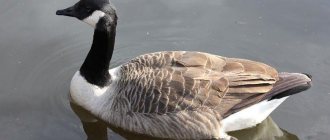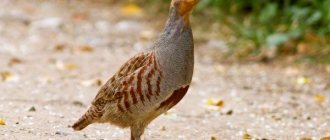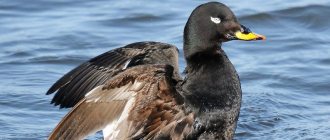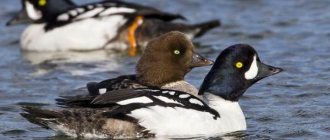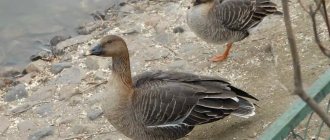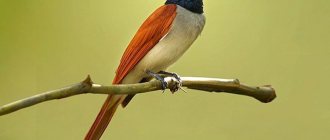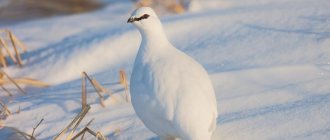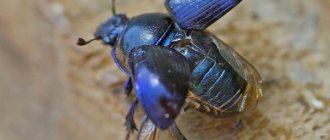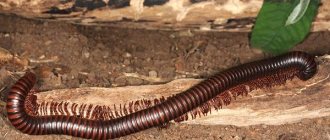| Latin name | Branta bernicla |
| English name | Brant goose |
| Squad | Anseriformes |
| Family | Duck |
| Body length, cm | 55-62 |
| Wingspan, cm | 105-117 |
| Body weight, kg | 0,8-1,2 |
| Features | The head, neck and chest are black; there is a whitish crescent on the neck; it is found only in adult birds. |
| Number | About 40,000 |
| Security status | Least Concern |
| Habitats | Breeds in the Arctic on swamps, islands and tundras. In winter, it lives in lagoons, river mouths, salt marshes near sandbars, barrier beaches and ocean shores. |
| Additionally | The brant goose is divided into three subspecies: the brant goose, Branta bernicla bernicla (Linnaeus, 1758), the pale-bellied goose, Branta bernicla hrota (Müller, 1776), and the American goose, Branta bernicla nigricans (Lawrence, 1846). |
- 2.1 Range
Description
The brent goose is a gregarious bird of the Anatidae family that forages for food by wandering in shallow water or along the coastline. During periods of migration, birds can fly up to several thousand km.
Number
— Advertising —
In the 1960s, the population fluctuated from 10,000 individuals and grew to 40,000 by 2010.
Structure and dimensions
The brant goose is a relatively small species that has a dark brown upper body as well as brown stripes along it. The lower part is pale gray. The head of the goose is black, the neck is short and black, and the beak is small. There is a white crescent-shaped spot on the neck. The species has the shortest tail of all types of geese. The lower part of the tail is white and the upper part is black. The birds also have black beaks and legs; the young ones have a red beak tip.
The dimensions of the species are as follows: average body length 55–62 cm, wingspan about 105–117 cm, weight approximately 860–1250 g.
Natural enemies
Red-breasted geese have a lot of enemies in nature, so they need the help of more agile and dangerous birds of prey. Without their protection, it is impossible for anseriformes to survive.
Animals that pose a danger to geese include:
- foxes;
- wolves;
- dogs;
- arctic foxes;
- hawks;
- eagles.
It is difficult for geese to defend themselves due to their small size. Adults run and fly nimbly, which allows them to hide from predators, but young individuals find it difficult to do this and cannot protect themselves on their own. But even in adulthood, birds have a hard time; they become vulnerable during molting. For this reason, during nesting, birds try to find a patron among other birds of prey, who can protect them along with the brood, protecting their own nest.
Bright color plays a negative role in the process of protection from dangers, since the nest with the female sitting in it is noticeable from afar. But more often than not, the bird is warned that danger is approaching, and it has every chance to save itself and its chicks by hiding in a safe place.
Despite the high danger from animals, the main enemy for geese has been and remains man and human activity. Although hunting these birds is prohibited by law, this does not stop poachers from being cruel to them. A long time ago, when the goose was not listed in the Red Book, it was almost completely exterminated, killing one individual after another. Another negative point is that most often oil and gas production and the construction of various structures and factories take place precisely in the nesting areas of red-breasted geese.
Habitat
— Advertising —
Breeds in the Arctic on swamps, islands and tundra. In winter, it lives in lagoons, river mouths, salt marshes near sandbars, barrier beaches and ocean shores.
Area
Breeds on the Arctic coasts of central and western Siberia. Winters in western Europe: more than half of the population is in the south of England, the rest is between northern Germany and northern France.
Appearance
Externally, the barnacle goose differs significantly from other representatives of the duck family. She has a black body, a white mask on her head, and a white apron covering her chest. There is also a brown color on the wings. It also differs in size from other ducks: its body length does not exceed 75 cm, and it weighs no more than 3 kg.
Many see the similarity of the appearance of the barnacle goose with the description of the monastic decoration. The combination of black and white is uncharacteristic of other ducks. Only one species - the Canada goose - has a similar color, which differs in that it seems to be done in reverse: its body is covered with white feathers, and there is a black mask on its head.
Nutrition
The main diet of the species consists of plant products. Birds forage in groups along shorelines, in shallow waters, and along tidal flats.
Migratory patterns of a species influence feeding depending on the time of year. During their winter migration to the Arctic, they consume marine food, which consists of green algae, sea lettuce and stone grass.
In their normal environment, geese eat sedge, algae and grass. Birds rarely consume insects, worms and shellfish. In summer, geese can be found in salt marshes and freshwater lakes feeding on moss.
Historically, the bird's diet was predominantly eel. In the 1930s, disease killed off most of these fish throughout the world, which also partly led to a decline in the goose population. The surviving birds adapted to an alternative diet - plant-based.
Now brant geese additionally obtain food on pastures, thanks to which they have been able to diversify their diet.
What does it eat?
The little Canada goose and other subspecies feed primarily on vegetation. The basis of their diet is plantain, wild grass, fescue, sedge, and other nutritious grasses. Some species, not only the Canadian one, feed on agricultural crops. Her diet sometimes includes corn and grain. Despite this predilection, the goose does not harm human crops.
Reproduction
Brent geese are monogamous and raise their young together.
The breeding season lasts up to 3 months and begins in June when weather conditions are favorable.
When birds arrive at breeding sites, females build nests in shallow depressions in the ground with down, moss and grass. A girl reaches puberty at the age of 2-3 years. The female incubates about 3-5 eggs for 22-25 days. At this time, the male protects the family from potential enemies and other birds.
Food
Basically, geese eat grass, horsetails, roots, and various greens. During the flight, their diet consists of dried plants from the steppe and semi-desert, various cereals and grain crops, such as barley and millet. Birds have to feed in the same place where they spend the night. They feed on the food that they obtained during the day, and under good circumstances they can find a watering hole.
During drought, red-breasted geese have to switch to food that they get in semi-deserts and even deserts.
Black goose in the Red Book
The main causes of death for this type of bird are sport and regular hunting, loss of habitat and a decrease in the amount of food. Geese are particularly susceptible to mortality as they return from extreme conditions in the Arctic and are therefore weakened by inadequate nutrition, travel and weather.
Another source of declining populations is the loss of eel fish due to habitat loss and wetland diseases. Birds are vulnerable to chemical pollution that enters estuaries from urban sources and agricultural runoff.
Countries such as Mexico, Canada and the United States have considered actions to mitigate the impact of habitat degradation for the species. Regulations have been put in place in Alaska and Canada to limit hunting and trapping of the species. Measures have also been introduced to prevent pesticides and pollutants from polluting rivers and streams entering watersheds from agricultural and urban sources.
Since the initial protection of brent geese in the 1930s, efforts have been made to conserve eel populations.
During the winter season, some birds live in parks along the coast in British Columbia, Canada. They have a "no dog" policy to reduce pollution and stress on the species.
Lifestyle
The red-breasted goose is a very tireless and active bird; in addition, it loves to communicate and adapts to new conditions quite easily. In flight, it is more like a red duck than a goose, with which it is constantly compared. During the non-moving period, birds are usually distinguished by their characteristics such as restlessness and constant movement from one point to another. If they were like geese, they would be more motionless and calm.
It has already been said that the goose is a waterfowl, so it has good ability to dive to depth. Descending into the depths, you can hear the various sounds it makes: a barely audible hoarse cackle, as well as a scream. Thus, representatives of this family communicate with each other and transmit information about whether it is safe there. In addition, sometimes you can hear sounds similar to a snake hissing.
For nesting houses, geese usually use bushes, as well as lichens on the tundra. In addition, when choosing a place, they use various criteria; it is desirable that the place is located on a hill, not far from the water, close to the weeds. They often hatch eggs on the coastal areas of rivers with sharp turns, and very rarely nest on rocks.
Interesting Facts
- The maximum lifespan of a brant goose is up to 27 years, but is usually around 19 years.
- The length of the bird from the tip of the beak to the tip of the tail is 56-61cm.
- The word "brent" comes from the Norwegian word "brend", which means "burnt". Geese were given this name because of their color, which is similar to charcoal.
- A single bird can travel more than 200,000 km in its lifetime between its winter habitat in the UK and its summer habitat in the Arctic tundra.
- This dark little goose is often mistaken for a duck.
- Geese have a highly developed salt gland, which allows them to drink salt water.
- The brant goose is one of the species to which the Treaty on the Conservation of African Migratory Waterbirds applies.
- Asian populations of the species were previously considered a separate subspecies orientalis based on the supposed lighter coloration of the upper parts. However, such assumptions have now been abandoned.
- Unlike the Canadian, the black type does not travel in a V-shaped flying formation. This type flies together in a grouped, disorganized flock.
- The species' northern habitat is expected to expand as global temperatures increase. Scientists expect the brant's winter range in the Pacific Northwest to soon extend into northern Canada and Alaska.
- This is a silent bird: its voice is quiet, similar to a nasal muttering.
Features of character and lifestyle
Photo: Goose in flight
Relatively little is known about the lifestyle of this species. They nest on flat areas of tundra near ponds and lakes, as well as on islands. During migration and in winter, geese are more closely associated with the coast than other geese, and they often spend time in the delta or shallow sea areas.
Geese are social birds and should have plenty of space and companions. They need plenty of space to graze as well as plenty of water. Their water source should also grow underwater vegetation.
No other geese nest as far north as the goose, and few migrate as far. These small geese are common in coastal areas in summer and winter. Most bird watchers know them from observing their wintering flocks along the coast. Traveling between their summer and winter outposts, they can fly at high altitudes, crossing vast expanses of land or open ocean.
The goose has strong wings that perform quick strikes. They fly in a compact herd or oblique line, sometimes in a well-opened V formation. During migration they fly low from the water. During the flight, a white fragment often catches the eye.
Interesting fact: The goose makes a low, guttural, rolling sound in flight. This nasal sound is almost similar to a grunt or deep booming bark and is carried over considerable distances.
In North America, geese winter along the Pacific coast from Alaska to Baja California and mainland Mexico, and along the Atlantic coast from Massachusetts to North Carolina (mostly New Jersey to North Carolina).
Since the mid-1960s, more than 80% of the estimated winter populations of Russia, Japan, and North America have lived in Baja California and other parts of northwestern Mexico. Geese overwinter primarily in marshy marine habitats, along lagoons and river mouths, and in shallow bays.
Where do birds like to nest?
After mating games and copulation, future parents begin to build nests. Most often, females prefer to plant them on the ground near rivers and lakes, so that there is always food nearby. But sometimes, in order to protect the “home” from destruction, females build it in the trees. This measure is necessary in regions where arctic foxes live, which love to eat eggs and chicks.
Canadians also build nests next to polar owls, which protect females while incubating eggs. However, there is an option that the bird will grab the goslings, which will go looking for food for themselves. If the nests are near the owls, the babies will need time to get to the food area. Geese also like to settle on small islands of land in the water so that they do not have to go far in search of food.
Shadrinsky geese
It is difficult to call this bird not resistant to frost, but it is important to make floors in the poultry house that will remain warm and dry. The optimal temperature for this breed is 18 degrees. The peculiarity of the bird is that it is not picky about food. When breeding geese, the farmer focuses on obtaining meat, since their weight is about 6 kg. The meat of Shadrinsky geese is very tasty and healthy. Goose down is very hard and is not in great demand.
The liver of the Shadrinsky goose reaches 400 g, which is why the birds are highly valued among breeders.
How is parenthood going?
Long-term observations of geese of this species have shown that they take a very responsible approach to their offspring. During the incubation process, the female pays great attention to protecting the eggs from bad weather and external aggressors, and lines the inside of the nest with her down. In one season, the goose lays at least 3 eggs (but no more than 6) with cream or white shells.
All month the goose carefully guards the nest and leaves it only to eat. At this time, the male is incubating, so the incubation process takes place almost without interruption. The goose is constantly next to his chosen one and, together with her, protects the eggs to the last when attacked by enemies.
In one flock, geese nest one after another with a difference of a couple of days, but hatching occurs almost simultaneously. Babies get on their feet and follow their mother already on the first day after birth, and begin to fly by 2.5 months. Until this time, parents take care of the goslings and help them look for food. Most often, chicks begin a completely independent life a year after birth.
Breed lifestyle
A female can have healthy offspring only in favorable conditions. Birds need clean water and lots of greenery. The flocks feed on the remains of wheat and barley after the harvest. The goose nests once a year, mainly in the summer, when there is plenty of green food and water.
Geese groups migrate in the fall before the onset of the first cold weather. Birds move along large rivers, even if this requires covering a large number of kilometers. Young animals of any species travel with adult geese and participate in obtaining food for the flock.
Types of wild geese: popular varieties of geese with descriptions and photos
Farming geese is a fairly profitable business. Geese are very polite and self-respecting poultry that carry considerable value. Goose meat and eggs are a real delicacy, and their down is highly valued in many industries.
In this aspect, it is not strange that goose farmers have a lot of valuable information about this breed and too often treat geese as exclusively domestic birds.
But we should not forget the fact that nature provides a motley list of wild geese, which are better known in hunting circles. They are often called geese.
Let's try to understand in more detail what a goose is and describe the features of the most popular species of this genus.
Canadian
Wild geese of this variety are one of the most representative among their relatives. They walk, proudly raising up their black head, contrastingly decorated with snow-white patches on the cheeks and part of the throat. White feathers are a reliable shield for the most delicate parts of the goose’s body: the underbelly and undertail.
Important! The body length of such a spectacular beauty ranges from 64 to 110 cm, and when flying, the bird’s body takes on the shape of a wedge.
Its average weight is 3 kg, but can reach 5.5 kg.
The top of the belly, chest and sides of the Canada goose are painted in dirty gray and chocolate colors that complement each other in waves. The wings of Canadian birds are also marked with the same wavy, but dark brown tint.
As for the tail feathers, they complement the color of the head and neck - they are distinguished by a rich black tint. Looking at this fact, one could say that the Canada goose is black from head to tail, but this is not entirely true.
Canadian chicks are especially endearing: they are tiny fluffy lumps of a delicate yellow color.
As for the life activity of this species of wild geese, they live near reservoirs and swampy areas, where they feel great both on land and in water.
Regarding their diet, we can say that these geese are mainly herbivores and feed on what grows in swampy surroundings. But they are not at all averse to eating fish or surface insects.
This species of birds is quite rare, so they are carefully protected.
The clutch of this variety contains an average of 9 eggs.
Black
If you compare the brent goose with its relatives described above, it looks rather inconspicuous. When looking at it from the front it appears completely black, but from the rear it appears white. The black neck is decorated with a white round ring.
With a rather fragile appearance, the body weight of the black goose is 1.2–2.2 kg, and the body reaches a length of up to 60 cm.
The female of this species lays from 3 to 5 eggs, of which she incubates tiny fluffy gray chicks for 24–26 days. At this time, the male helps his “wife” as best he can.
As for the menu of black geese, they are solid vegetarians.
Hunting for this bird is strictly prohibited.
White-cheeked
The barnacle goose is an inhabitant of not only the wild, but also the Red Book. Its description should begin not so much with the original color, but with its habitat. Compared to other representatives of the goose genus, it nests in mountain gorges and on rocks, hides nests in hard-to-reach places, and prefers the Arctic habitat, the tundra.
As for the color of this bird, it attracts attention with the delicate white plumage of its head on a contrasting black neck. The back and wings of the white-cheeked beauty are painted red with a bluish tint, which looks especially elegant when the bird is flying. The belly and undertail of the barnacle goose are snow-white in color.
An adult bird weighs 1.5–2 kg, and its body reaches a length of 58–70 cm. They live in flocks. In terms of diet, they also belong to vegetarians.
Hawaiian
The owner of not only a loud exotic name, but also a unique appearance, the Hawaiian goose most closely resembles ordinary geese. But its wayward color, in which black, gray, white and brown shades are reunited, gives it some originality and zest. This goose is easily recognized by the white and brown “necklace” on its neck.
With a body length of 55 to 170 cm, such a goose weighs 1.5–3 kg.
Important! The population of Hawaiian geese, unfortunately, is rapidly declining, and therefore they are listed in the International Red Book.
In the wild they are found in the Hawaiian Islands, and in our conditions they are inhabitants of zoos.
The average lifespan of these birds in natural conditions is about 20 years, and in captivity they can live from 24 to 42 years, with males living longer, while females often die during the breeding season.
Due to poorly developed membranes on their feet, Hawaiian geese do not feel well in the water and spend almost their entire lives on land.
As for reproduction, these geese build clutches in depressions in the ground, where from 3 to 5 chicks hatch for 29 days.
Source: https://agronomu.com/bok/5123-obschaya-harakteristika-i-vidy-chernyh-gusey-kazarki.html
